Effective Factors on Successful PCI of CTO Lesions
Author'(s): Shima Haghani*
Senior Cardiovascular Disease Researcher, Department of Clinical Research, Tehran Heart Center, Tehran University of Medical Sciences, North Kargar Street, Tehran, Iran.
*Correspondence:
Shima Haghani M.D, Cardiovascular Disease MSc, Senior Cardiovascular Disease Researcher, Department of Clinical Research, Tehran Heart Center, Tehran University of Medical Sciences, North Kargar Street, Tehran, Iran, Tel: +98 2188029256, Fax +98 2188029256, E-mail: Sh_Haghani1@yahoo.com.
Received: 14 Apr 2022; Accepted: 20 May 2022; Published: 25 May 2022
Citation: Haghani S. TEffective Factors on Successful PCI of CTO Lesions. Cardiol Vasc Res. 2022; 6(3): 1-5.
Keywords
Introduction
A significant factor is a term, which stated that an average reaction of the human with diffusion divided by the average rate of reaction. If the reaction rate has found at a bulk value, then the process is applicable. Angioplasty is a process that helps restoration of blood flow takes place with the help of arteries for easy flow within the body; in this case, the doctors thread a thin tube through the blood vessel. It has generally provided in the arm or groin, at the end of the line a tiny balloon-like structure is present. In this assignment, this study aims to describe the significant problems that have been associated with Angioplasty like the one PCI and CTO have highlighted along with it in several discussions.
Brief idea about PCI
Percutaneous Coronary Intervention, which can know as PCI, is a non-surgical method, which has carried out by using a catheter. This process has done by using a catheter, is a thin tube of flexible nature that helps to place a small structure named a stent to open the blood vessels in the heart. Further, it has narrowed through Plaque build-up, which has also known as atherosclerosis, when the operation has done, the patients it has carried out for 30minutes to two hours. As per the influence of Tanaka et al., [1], generally, it has completed within one hour; many people think that the placement of stents shortens the period.
It has found that with this process of the stent, no need for future Angioplasty has not seen through various research. According to Numasawa et al., [2], again from the Duke Research institute, the researcher found that the stents have no relation with mortality in the long term. In the operation of a stent, there is a little or a negligible amount of risk present, if it generally comes back within six to nine months, and due to this, another stent has operated.
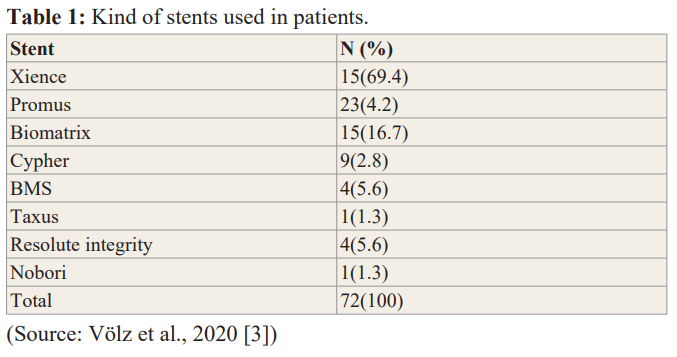
The process of PCI has a high risk during the operation if the person has a previous record of kidney diseases along with stroke and diabetes. According to Cannon et al., [4], the PCI has done when the duration present is twelve to twenty-four hours when several congestive heart failures take place along with continued angina. Primary PCI has not recommended when the symptoms mentioned above have seen more than twelve hours, and the patient remains unconscious.
It has found that when the PCI has used to treat the multivessel coronary artery diseases (CAD), several interventions have performed during the various stages (which carried out in one or more stages). According to Völz et al., [3], about half of the patients found that their CAD blockage occurs in multiple positions and more than twenty per cent of the people undergo PCI and receive treatment in one or more than one vessel. After the operation, it was seen that a patient, after taking a rest of one or two days they can start walking with the advice of the doctors. After a few days from discharge, the patient can resume their exercises and usually drive as before.
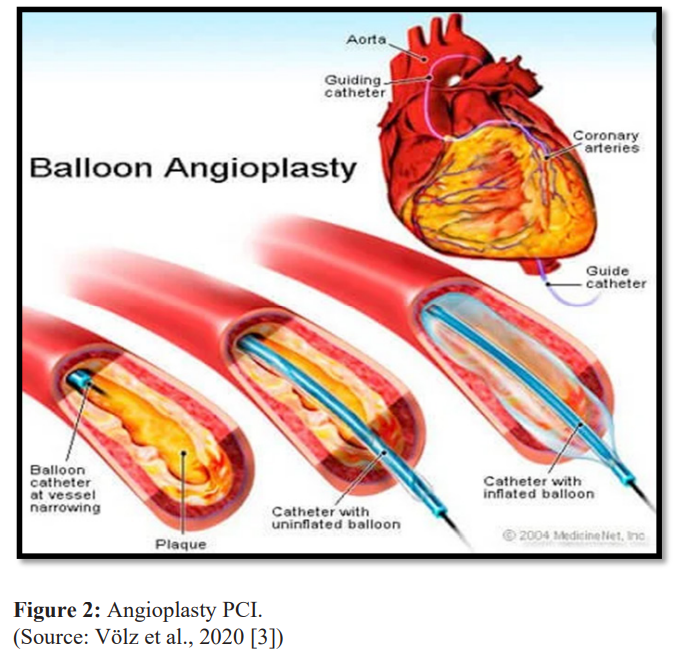
Brief idea about CTO Lesions
Chronic total occlusion, which is also known as (CTO) generally seen in the patient associated with heart disorder involved with coronary artery diseases. The CTO lesions that have also carried with TIMI flow, provided in the occluded segment along with that angioplasty evidence carried out in more than three months. According to Rawlins et al., [5], the CTO PCI is a technique in which the patients have treated with complete blockages along with the chronic total occlusion of the coronary arteries. As per the influence of Gosling et al., [6], the CTO is representing the most challenging problems in the department of cardiology, in this process, a complete blockage present nearly three months.
There have various steps to treat the CTO of the coronary artery such have mentioned below-
- Bypass grief surgery- It is a process of surgery, which helps to redirect the blood flow, surrounding the blocked artery and has generally expected in countries like the United States. According to Eftychiou et al., [7], conducting the bypass surgery the surgeon takes the new blood vessel from another part of the body and connects those blood vessels beyond the arteries, which have blocked, in this way the bypass has done.
- Coronary Intervention- It is a non-surgical procedure usually carried out to treat the narrowing of the arteries associated with coronary included in the diseases of the coronary artery. According to Sirker et al., [8], this process also helps to improve the flow of blood to the heart; along with that, the catheterization process associated with PCI contains the iodine-based injection to the coronary arteries.
- Percutaneous Coronary Intervention, along with Angioplasty and stenting- The Percutaneous Coronary Intervention has also known as the coronary Angioplasty, is also a non-surgical procedure that improves the flow of blood.

From the above case studies it was found that, there were several patients across the country with several types of heart diseases among them some of the patients has chosen to conduct the test. Many governments across the world have provided significant effort in conducting the CTO tests and make it successful, so that the medical industry can reach at a certain extent. From the first case study, it has found that in India 146 patients has undergone through this tests, it has found that about ninety-seven percent of the people survive through it. In the next one year, it has found that a significant drop of major cardiac event rates and the operation of CTO becomes a great success. As per the influence of Ybarra et al. [9], in the next case study, it has found that the research has taken place with thousands of patients submitted with OCT PCI.
However, within one year it has seen that one hundred and eighty four patients showed a huge improvement and the doctor’s works very hard to provide the quality life towards their patients. As per the influence of Namazi et al. [10], along with that, more than seven hundred patients have provided significant response through the drug therapy along with the well develop collaterals. The combined use of the prognostic analysis, which has carried out through forty-two months, showed a huge decrease in the death associated with cardiac related problems. In the next step, a research showed that have more than three hundred patients with acute myocardial infarction who has gone through a primary PCI and CTO in a non-infarct related artery.
In the last stages it has found that in Brazil, have remains unsuccessful in these operations in the year 2016 as there have insufficient materials that have required for conducting a successful operation. In the last case study it has found that Seventy-two numbers of patients has enrolled for the cross sectional study in related with the diagnosis of the CTO. It has carried out in the year 2012 and 2013, which includes fifty-four patients from the Modarres hospital and eighteen percent from the Iranmehr Hospital in Iran. As per the influence of Mehta et al. [11], the diagnosis of the CTO process includes the TIMI Flow and a period of destruction for more than three months.
The test has performed based on age, gender, affected vessel, calcification, length of lesion, retrograde flow to support the successful wiring. From this test, it has found that basic characteristics and demographic table has represented in the case study, which clearly shows that several consequences keeping in mind while conducting the test.
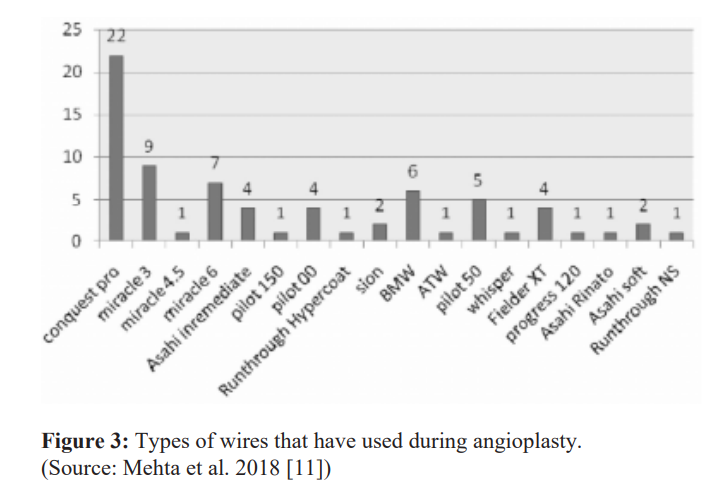
Due to the advancement of technology, several directions has provided in the field of operations of CTO and PCI. Due to this, the operation becomes successful in these days and many persons have recorded undergoing through this test.
Discussion of the topic and their relations
In recent time with the advancement of technology, several modern types of equipment also arrived, which made the operations very smooth and easy. In this way, the risk that was associated with the procedure regarding the Angioplasty or bypass surgery has decreased largely. Most of the people returning home with a successful operation and regularly leading their life, along with it makes this surgery effective and efficient. According to Schumacher et al., [12], at the initial stages ante grade wiring approach was used to conduct the process, and it was found that due to this it took much time to complete a successful CTO PCI operation.
Apart from the time-consuming process, the success rate has also minimized with this process, and many complications again arise, which makes the complexity in the CTO Parameters. As per the influence of Wilson et al., [13], the CTO lesion parameters were the length of the lesion, bridging collaterals, along with poor distal vessel visualization. In this stage, a success rate was present nearly seventy per cent, but afterwards, with the successful wiring of the CTO segment, the success rate increased at a great extent up to ninety-seven per cent. After the success, a controversy arises that CTO PCI has a direct impact on the clinical and angiographic factors regarding the technical equipment and clinical outcomes. According to Allahwala et al., [14], the presence of blunt stump and bridging collaterals faced multivessel diseases and several tortuosity’s that has no impact on the success or failure rate of CTO PCI.
The technical success to deal with CTO and PCI has a great success towards the interventional cardiologist but keeping in mind the safety of their patients. According to the cardiologists, it has found that failures with complication are worse than success with severe complications.
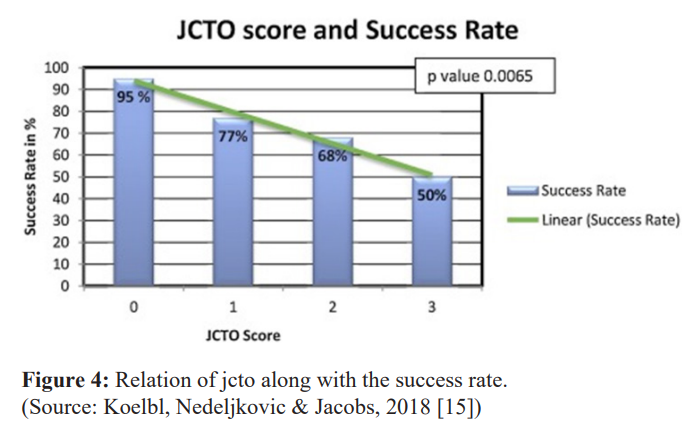
The most common complications occurring during the CTO PCI are perforations along with the donor vessel dissection remains considerable as variability in the rates of complication. According to Stojkovic et al., [16], the amount of percentage that affects different category has mentioned in the form of a list below-
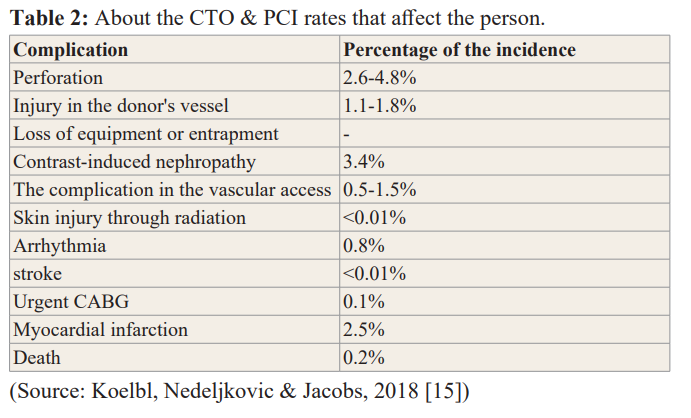
Problem related to PCI & CTO LESIONS
Though the advancement of technology is occurring day by day, and it has quickly adopted in the field of the medical industry, it has some disadvantages also. PCI & CTO were the most challenging procedures for inventory cardiologist to deal with coronary artery diseases. According to Obedinskiy et al., [17], due to this complexity, there was an increment in the compilation rate as compared to the PCI for the treatment of the non-occlusive diseases. The CTO- PCI based complications seemed to arise after the operation has invert occlusion of donor's vessels. Along with this, the injury of the collateral channels causes hemodynamic instability or ischemia. Afterwards, several complications have provided along with it a brief discussion below-
- Chronic total occlusion- It is a common type of occlusion generally seen among the angiography patients associated with the coronary artery diseases. In research, it has seen that about twenty per cent of the people had affected by these diseases. According to Koelbl, Nedeljkovic & Jacobs [15], along with this, it has found that about ten per cent of the CTO patients have undergone through PCI, besides that only seven per cent patients successfully gone through this process.
- Perforation and collateral channel injury- Coronary Perforation is a common complication for the CTO-PCI, in case if any person left undiagnosed or not provided with any treatment later, it causes a life threat. As per the influence of Suzuki et al. [18], the familiar scenes that have created during the process showed that the guidewire existed in the body of the CTO patients during the ante-grade wire During the process of Perforation, the bleeding occurs is an unusual process. Still, one to two per cent of the patient registers bleeding along with that five per cent of patients undergone through open CTO.
- The issue with the donor's vessel- It has found that if the retrograde approach was not present little implication present from seating a catheter in a non-CTO Sometimes in the case of ischemia or arrhythmia, single catheter injection was much safer than other modes. Donor vessel occlusion occurs due to the thrombus formation avoided at all costs; instead, this complication can occur in the target vessels when the ante grade CTO-PCI carried out. According to Okamura et al., [19], along with it has seen that the risk is much higher while conducting retrograde access, this type of occlusion occurs very rarely. This kind of occlusion has generally seen when the retrograde equipment has withdrawn from the CTO Vessel, in these circumstances the energy and friction that has previously been stored in the system released during the micro catheter crossing.
- Associated myocardial injury- It has considered as the common injury in which a small increase occurs in the cardiac enzyme, which has a connection with retrograde approaches. According to Koelbl, Nedeljkovic & Jacobs [15], if a dominant collateral channel has used during this period and the patient faces several significant ischemia’s and chest pain is crossed; the operator offers an alternative strategy to minimize the myocardial infarction.
Conclusion
In the assignment, the significant factors that were associated with the successful PCI of CTO lesions have discussed with several images to provide a clear idea about the topic. In the first step, an introduction has provided, which comprises a brief aim of the project. In the next step, a quick idea about PCI has discussed which delivers the meaning, use and its effectiveness. Along with that, the CTO has consulted with definition and its use and how decreases the risk while conducting the operation. Later the relation among them has drawn while taking help from technological equipment and clinical benefits. In the coming steps, the effects from these diseases have discussed, and lastly, the differences associated with them have produced briefly. It has found that with the progress of the technological aspects, equipment has developed which made the operation easy, comfortable along with that reduces the risk at a great extent.
References
- Tanaka H, Ong ME, Siddiqui FJ, et al. Modifiable factors associated with survival after out-of-hospital cardiac arrest in the Pan-Asian resuscitation outcomes study. Annals of emergency medicine. 2018; 71: 608-617.
- Numasawa Y, Inohara T, Ishii H, et al. Comparison of outcomes after percutaneous coronary intervention in elderly patients, including 10 628 nonagenarians: Insights from a japanese nationwide registry (J-PCI Registry). Journal of the American Heart Association. 2019; 8: e011183.
- Völz S, Petursson P, Odenstedt J, et al. Ticagrelor is not superior to clopidogrel in patients with acute coronary syndromes undergoing PCI: a report from Swedish coronary angiography and angioplasty Journal of the American Heart Association. 2020: 9: e015990.
- Cannon CP, Gropper S, Bhatt DL, et Design and Rationale of the RE-DUAL PCI Trial: A Prospective, Randomized, Phase 3b Study Comparing the Safety and Efficacy of Dual Antithrombotic Therapy With Dabigatran Etexilate Versus Warfarin Triple Therapy in Patients With Nonvalvular Atrial Fibrillation Who Have Undergone Percutaneous Coronary Intervention With Stenting. Clinical cardiology. 2016; 39: 555-564.
- Rawlins J, Ludman PF, O'Neil D, et Variation in emergency percutaneous coronary intervention in ventilated patients in the UK: Insights from a national database. Cardiovascular Revascularization Medicine. 2017; 18: 250-254.
- Gosling R, Morris P, Lawford P, et al. Virtual (computed) FFR and Virtual Coronary Intervention (VCI) vs angiography for guiding PCI: a virtual study. In Heart. 2019; 105: 45-45.
- Eftychiou C, Barmby DS, Wilson SJ, et al. Cardiovascular outcomes following rotational atherectomy: a UK multicentre experience. Catheterization and Cardiovascular 2016; 88: 546-553.
- Sirker A, Kwok CS, Kontopantelis E, et al. Antiplatelet drug selection in PCI to vein grafts in patients with acute coronary syndrome and adverse clinical outcomes: Insights from the British Cardiovascular Intervention Society database. Catheterization and Cardiovascular 2018; 92: 659-665.
- Ybarra LF, Cantarelli MJ, Lemke VM, et al. Percutaneous coronary intervention in chronic total occlusion. Arquivos brasileiros de cardiologia. 2018; 110: 476-483.
- Namazi M, Safi M, Vakili H, et al. Evaluation of effective factors in success rate of intervention on CTO. Acta Medica Iranica. 2015; 173-176.
- Mehta AB, Mehta N, Chhabria R, et al. Predictors of success in percutaneous Coronary intervention for chronic total occlusion. Indian Heart Journal. 2018; 70: S269-S274.
- Schumacher SP, Driessen RS, Stuijfzand WJ, et Recovery of myocardial perfusion after percutaneous coronary intervention of chronic total occlusions is comparable to hemodynamically significant non-occlusive lesions. Catheterization and Cardiovascular Interventions. 2019; 93: 1059-1066.
- Wilson WM, Walsh SJ, Bagnall A, et al. One-year outcomes after successful chronic total occlusion percutaneous coronary intervention: The impact of dissection re-entry techniques. Catheterization and Cardiovascular 2017; 90: 703-712.
- Allahwala UK, Brilakis ES, Byrne J, et Applicability and Interpretation of Coronary Physiology in the Setting of a Chronic Total Occlusion. Circulation: Cardiovascular Interventions. 2019; 12: e007813.
- Koelbl CO, Nedeljkovic ZS, Jacobs AK. Coronary chronic total occlusion (CTO): a review. Reviews in cardiovascular medicine. 2018; 19: 33-39.
- Stojkovic S, Juricic S, Dobric M, et Improved propensity-score matched long-term clinical outcomes in patients with successful percutaneous coronary interventions of coronary chronic total occlusion. International Heart Journal. 2018; 59: 719-726.
- Obedinskiy AA, Kretov EI, Boukhris M, et al. The IMPACTOR-CTO Trial. JACC: Cardiovascular Interventions. 2018; 11: 1309-1311.
- Suzuki S, Okamura A, Iwamoto M, et al. New CTO-specific IVUS: Ante Owl success in previously failed CTO case treated with Navifocus JACC: Case Reports 2020; 2: 961-965.
- Okamura A, Iwakura K, Iwamoto M, et al. Tip detection method using the new IVUS facilitates the 3-dimensional wiring technique for CTO JACC: Cardiovascular Interventions. 2020; 13: 74-82.